Clément
Ader
(1841-1926)
Self-taught French
engineer and inventor, and a pioneer of flight before
the Wright brothers.
Clément Ader, (b. Feb. 4, 1841, Muret, France--d. March 5,
1926, Toulouse) was an early enthusiast of aviation who
constructed a balloon at his own expense during the
Franco-German War of 1870-71. In 1876 he quit his job in the
Administration of Bridges and Highways to make more money to
support his hobby. His early inventions in
electrical-communications included a microphone and a
public-address device.
He then focused on the
problem of heavier-than-air flying machines and in 1890
built a steam-powered, bat-winged monoplane, which he named
the Eole. On October 9 he flew it a distance of 50 m
(160 feet) on a friend's estate near Paris. The steam engine
was unsuitable for sustained and controlled flight, which
required the gasoline engine; nevertheless, Ader's short hop
was the first demonstration that a manned heavier-than-air
machine could take off from level ground under its own
power.
Between 1894 and 1897
Clément Ader built a larger but still 'batlike' twin screw
machine which he named the Avion.
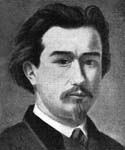
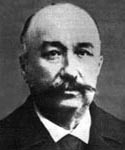
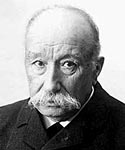
The Eole

Clément Ader's 'Eole'
in Flight

Clément Ader's 'Eole'
Patent Drawings

Clément Ader's 'Eole',
(Front Elevation)

Clément Ader's 'Eole',
(Plan)

Clément Ader's 'Eole',
Fuselage, (Plan)

Clément Ader's 'Eole',
wing detail, (Plan)

Clément Ader's 'Eole',
wing detail, (Front Elevation)

Clément Ader's Eole,
(Side Elevation Alt.)
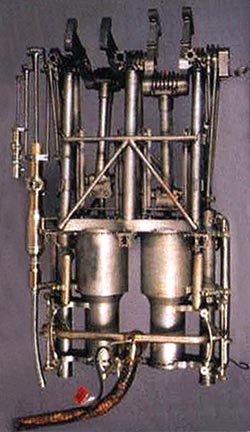
Clément Ader's Eole,
Motor

Clément Ader's Eole
Clément Ader's Avion III, the "Bat"
Clément Ader's Avion III,
otherwise known as the "Bat", one of the centrepieces at the
Musée des arts et métiers, was restored in the 1980s by the
Musée de l'air et de l'espace at its workshop in Meudon,
near Paris.
The aircraft, which has a wingspan of over 15 metres and is
equipped with two 20-HP steam engines and two propellers,
was built between 1894 and 1897 in Paris, in the rue Jasmin
workshop. The materials used were basically wood and, for a
small number of parts, steel, brass and aluminium. The web
on the wings was made from silk pongee which, in spite of
its tight weave, is permeable to air.
Experiments on the prototype, which required a considerable
amount of work, began in October 1897. Interrupted after an
accident, the work was not continued due to a lack of
financial resources. However, Ader claimed that a 300-metre
flight had taken place, a fact confirmed by two witnesses.
Biruta Kresling was given the opportunity of studying the
airplane close at hand when it was 'dissected' - 'taken to
pieces', enabling her to find out all the details relating
to its manufacture and produce a series of drawings. She was
immediately struck by the great intuition shown by Ader in
transposing the mechanical principles of bat flight,
particularly that of the flying fox.
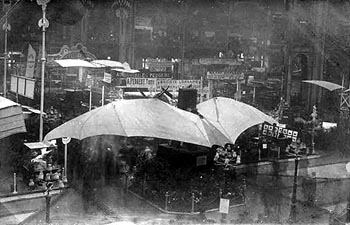
Clément Ader's Avion
III in 1908
With the impression of experiencing a remarkable adventure,
Biruta Kresling laid bare the aircraft's design, revealing
the astonishingly bionic (before the term was coined)
elements which inspired Clément Ader, engineer and
prodigious inventor, and examining the new ideas he
introduced.
Although the 'Bat' plane remains virtually unknown outside
France, and in spite of the fact that Ader's copy of the
natural model (faithful right down to the terms he used -
'arm', 'forearm', 'fingers', 'elbow', 'wood') seems naive
and clumsy today, all these technical concepts, for which
Ader had no theoretical bases or experimental means at his
disposal other than those he used himself (large flying
models, a glider, the Eole aircraft and, finally, the
life-size plane itself), were extremely advanced for the
time.
The resemblances between the aircraft and the animal are by
no means coincidental. Ader did in fact recommend building
the wings of low-speed planes on the model of a bat's wing,
and those of high-speed planes on the model of a bird's
wing.
Among the many
similarities between 'Avion III' and the flying fox or
birds, we will look at just a few examples.
Doubtless aware that the
pilot would be unable to steer such a complex aircraft
without the assistance of self-stabilizing devices,
depending on the shapes and materials used, Ader invented
mechanisms such as propeller blades inspired by the quills
in birds' wings, made of paper and bamboo - a sort of 'propfan'
and blade 'with automatic variable pitch'. The shaft of the
propeller blades consisted in a central strand made of cork
onto which thin sheets of split bamboo were assembled and
stuck. The unit was mounted in such a way as to flatten out
at high speeds, automatically regulating the angle of
incidence.
The 'thumb' of the flying
fox combines two functions: firstly, the unfurling and
automatic tensing of a membrane similar to the 'leading edge
flap' in an aircraft, followed by the folding back of the
wing, with the thumb now acting as a hook enabling the bat
to grip onto the branch of a tree. The same coupled
mechanism - a safety device for the animal - gave Ader's
flying machine, designed for military aviation, an
essential, dual function: the wing could be tensed and then
folded back, meaning that large wing surface areas could be
reduced. A single mechanism thus facilitated the processes
of putting the aircraft into operation rapidly by unfurling
the wings, bringing it to rest, transporting it from the
airfield to the hangar, followed by fast, easy removal and
dissimulation once it had landed.
X-rays of the 'arm' of
Avion III showed its hollow inner space to be criss-crossed
with thin wooden rods driven into the sides of the tube.
These make the arm rigid, similar to the bony trabeculae -
the thin rods which reinforce the humerus in birds.
As Director of the Musée
de l'air et de l'espace, General Pierre Lissarrague
supervised restoration work on the plane. He began by
carrying out a critical study of the countless technical
notes in Clément Ader's workshop notebooks. In order to
check that Ader's ribless wing did indeed have the hollow
profile announced in the patent, Lissarrague came up with
the idea of testing an original half-wing from the plane,
with its 'arm-bones' and 'fingers', covering it with a new
layer of silk pongee, just like the one on the original wing
which was used as a model, and exposing it to natural wind.
The experiment took place outdoors, on the west coast of the
Cottentin peninsula. The 'automatic ' curve of the thin
'fingers' and the membrane of the aircraft could thus be
observed in simulated flight, as could the profiles along
its wingspan. The placing of reflective strips under the
wing enabled the shape of these profiles to be photographed,
while measuring the way in which they are positioned in
relation to one another.
|
